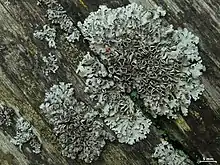Imshaugia
Imshaugia is a genus of five species of foliose lichens in the family Parmeliaceae. They are commonly known as starburst lichens.
| Imshaugia | |
|---|---|
.jpg.webp) | |
| Imshaugia aleurites in the Great Smoky Mountains, North Carolina. Scale bar is 1 cm | |
| Scientific classification | |
| Kingdom: | Fungi |
| Division: | Ascomycota |
| Class: | Lecanoromycetes |
| Order: | Lecanorales |
| Family: | Parmeliaceae |
| Genus: | Imshaugia S.L.F. Mey. (1985) |
| Type species | |
| Imshaugia aleurites (Ach.) S.L.F. Mey. (1985) | |
| Species | |
|
I. aleurites | |
Taxonomy
The genus was circumscribed by Susan Meyer in 1985 as a segregate of Parmeliopsis. In a previous study of Parmeliopsis,[1] Meyer noted a group of species (represented by P. aleurites and P. placorodia) that would be better accommodated in a separate genus. This had been previously noted by other lichenologists: in 1932, Vilmos Gyelnik proposed the section Pallidifera to include the grey species of Parmeliopsis;[2] in 1936 Johannes Hillmann proposed section Rectoconidia to contain species with short and straight conidia.[3] Meyer created Imshaugia on the basis of its emergent and partly marginal pycnidia (they are immersed and laminal in Parmeliopsis), its short, ampulliform (flask-shaped) or bifusiform (tapering at both ends) conidia (these are long and curved in Parmeliopsis), and the presence of Cetraria-type lichenan in its cell walls rather than isolichenan as in Parmeliopsis.[4]
The generic name honours Henry Andrew Imshaug, "in recognition of his contributions to lichenology."[4] Imshaugia species are commonly known as "starburst lichens".[5]
Description
Imshaugia lichens are foliose with a mineral-grey to whitish-grey thallus and a whitish to light brown lower surface.[4] They grow as small rosettes, comprising small lobes measuring 1–2 mm wide. Pseudocyphellae and soredia are absent from the thallus, but isidia may be present.[5] The upper cortex is paraplectenchymatous (a cell arrangement where the hyphae are oriented in all directions), measuring 10–20 μm thick, and covered by an epicortex with pores.[6]
The apothecia are Lecanora-type, resembling large, concave brown discs. Ascospores are colourless, ellipsoid, and number eight per ascus. Conidia have a short bacilliform shape with a swelling towards one end, and measure 3–4.5 μm long.[5] The phycobiont in Imshaugia is green algae – Trebouxia in I. aleurites, and Myrmecia in I. placorodia. The thallus contains thamnolic acid and atranorin.[6]
Habitat and distribution

Imshaugia grows most commonly on the bark and wood of conifers, and prefers woodland habitats that are open and well-lit.[5] They have also been recorded on hardwoods and wood fences.[4] The South American species I. sipmanii, however, is saxicolous.[7] Imshaugia placorodia has been noted to display a preference for the bark of the tree species pitch pine (Pinus rigida) and Jack pine (Pinus banksiana). The type species, Imshaugia aleurites, is widely distributed in northern North America, having been recorded from the tree line in the Arctic south through all of the boreal region and most of the temperate region.[6]
Species
- Imshaugia aleurites (Ach.) S.L.F.Mey. (1985)
- Imshaugia placorodia (Ach.) S.L.F.Mey. (1985)
- Imshaugia pyxiniformis Elix (2004)[7] – Brazil
- Imshaugia sipmanii Elix (2004)[7] – Venezuela
- Imshaugia venezolana (Hale) Elix (2004)[7] – Venezuela
The species Imshaugia subarida, proposed by John Elix in 2004 (a new combination from genus Canoparmelia),[7] has since been transferred to Austroparmelina.[8]
References
- Meyer, Susan L.F. (1982). "Segregation of the new lichen genus Foraminella from Parmeliopsis". Mycologia. 74 (4): 592–598. doi:10.2307/3792746. JSTOR 3792746.
- Gyelnik, V. (1932). "Über einige Arten der Gattung Parmeliopsis (Stiztenb.) Nyl". Annales Mycologici (in German). 30: 456–459.
- Hillman, J. (1936). Rabenhorst, L. (ed.). Parmeliaceae. Kryptogamen-flora von Deutschland, Österreich und der Schweiz. 9 (2 ed.). Leipzig: Eduard Kummer.
- Meyer, Susan L.F. (1985). "The new lichen genus Imshaugia (Ascomycotina, Parmeliaceae)". Mycologia. 77 (2): 336–338. doi:10.2307/3793090. JSTOR 3793090.
- Brodo, Irwin M.; Sharnoff, Sylvia Duran; Sharnoff, Stephen (2001). Lichens of North America. Yale University Press. pp. 360–361. ISBN 978-0300082494.
- Hinds, James W. (1999). "Lichen flora of eastern North America: the genera Parmeliopsis and Imshaugia". Mycotaxon. 72: 271–288.
- Elix, John A. (2004). "Two new species of Imshaugia (Ascomycota: Parmeliaceae) from South America". Mycotaxon. 90 (2): 337–341.
- Crespo, Ana; Ferencova, Zuzana; Pérez-Ortega, Sergio; Elix, John A.; Divakar, Pradeep K. (2010). "Austroparmelina, a new Australasian lineage in parmelioid lichens (Parmeliaceae, Ascomycota)". Systematics and Biodiversity. 8 (2): 209–221. doi:10.1080/14772001003738320. S2CID 84715679.